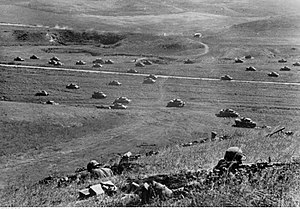
Back جبهة القوقاز Arabic Qafqaz döyüşü Azerbaijani Битка за Кавказ Bulgarian Emgann ar C'haokaz Breton Bitva o Kavkaz Czech Nordkaukasische Operation German Batalla del Cáucaso Spanish Kaukaasia lahing Estonian نبرد قفقاز Persian Kaukasian taistelut Finnish
This article includes a list of general references, but it lacks sufficient corresponding inline citations. (October 2008) |
| Battle of the Caucasus | |||||||||
|---|---|---|---|---|---|---|---|---|---|
| Part of the Eastern Front of World War II | |||||||||
 German tanks in formation in a Caucasus valley with infantry in the foreground, September 1942 | |||||||||
| |||||||||
| Belligerents | |||||||||
|
|
| ||||||||
| Commanders and leaders | |||||||||
|
|
| ||||||||
| Strength | |||||||||
|
July 1942: 170,000 men 1,130 tanks 4,500 guns and mortars ~1,000 aircraft January 1943: 764,000 men 700 tanks 5,290 guns and mortars 530 aircraft |
July 1942: 112,000 men 121 tanks 2,160 guns and mortars 230 aircraft January 1943: 1,000,000+ men ~1,300 tanks 11,300+ guns and mortars 900 aircraft | ||||||||
| Casualties and losses | |||||||||
| 281,000 casualties | 344,000 casualties | ||||||||
The Battle of the Caucasus was a series of Axis and Soviet operations in the Caucasus as part of the Eastern Front of World War II. On 25 July 1942, German troops captured Rostov-on-Don, opening the Caucasus region of the southern Soviet Union to the Germans and threatening the oil fields beyond at Maikop, Grozny, and ultimately Baku. Two days prior, Adolf Hitler had issued a directive to launch an operation into the Caucasus named Operation Edelweiß. German units would reach their high water mark in the Caucasus in early November 1942, getting as far as the town of Alagir and city of Ordzhonikidze, some 610 km from their starting positions. Axis forces were compelled to withdraw from the area later that winter as Operation Little Saturn threatened to cut them off.